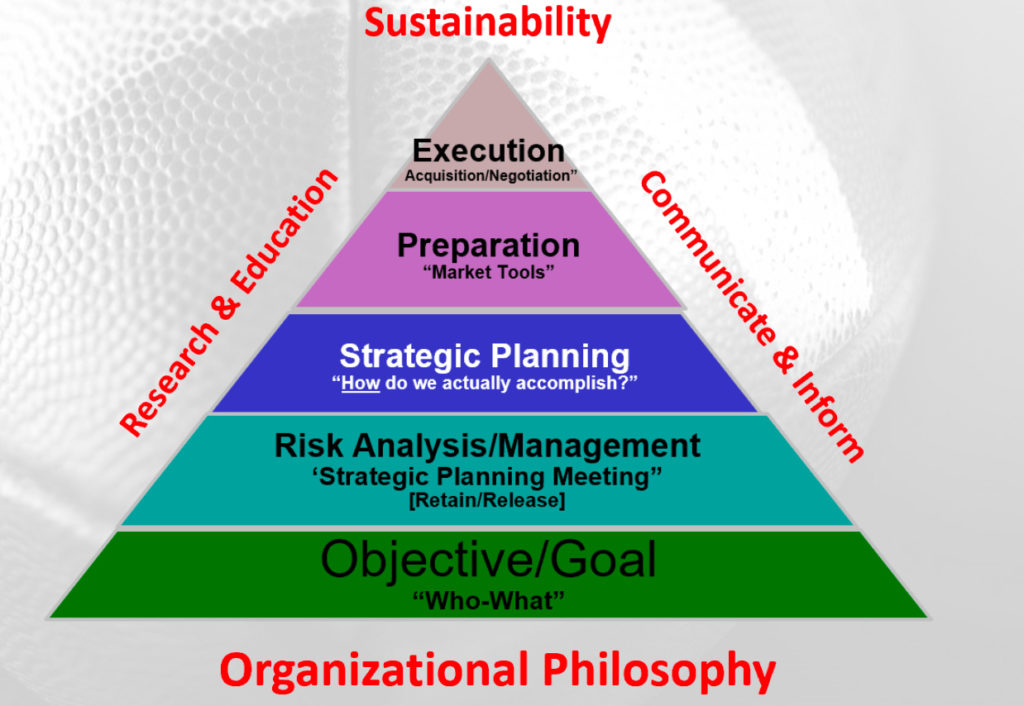Breakdowns
10/25/21
8 min read
NFL Contract Negotiations Part 1: Developing Procedures and Policies

This article will be the first in a three-part series on NFL contract negotiations. We’ll start by discussing the importance of organizational philosophy and club procedures. This will be a philosophical article covering policies that club’s must decide prior to entering contract negotiations. In part two of the series, we will focus on research and market analysis when preparing for a negotiation. In the third and final article, we will focus on the negotiation process, including how to best prepare to negotiate with an agent and how to develop a strategic plan for the initial proposal to closing the deal.
Consistency is Key
Organizational philosophy regarding contract negotiations is the foundation of an organization’s ability to attain long term success and sustainability. Each club has its own operating procedures, which allows them to build a team roster within that philosophy.
Every team has a dedicated staff (usually their football administration or operations departments) that assists the General Manager (and for some an Assistant GM) to research, evaluate, and track league-wide contract trends. Information is reviewed and studied based on:
- Contract Structures (which include signing bonus/option bonus/roster bonus, etc.)
- Salary cap impact
- Cash flow
- Guaranteed monies (types of guarantees include skill/injury/salary cap)
- Three-year cash
- Average per year (APY)
The GM and his staff set the strategic vision for their club’s contract negotiations.
Because there are many ways to acquire players when building a roster, this contract information can help a GM, Assistant GM, and player personnel department make informed decisions. The following decisions need to be made:
- Retaining and re-signing players on the current roster
- Acquiring a player from another club (through Free Agency, a claim, or a trade)
- Acquiring a Street Free Agent
- Drafting a player
The cost analysis (both salary cap and cash) of the replacement of a player becomes a piece of the strategic plan. As a team’s GM works with their Head Coach to build their roster, communication and collaborative decision making based on risk analysis and strategic planning is a key part of an organization’s ability to sustain success.
Consistency in contract language is very important. There are many requests to adjust language for individual contracts. It becomes much easier to remain consistent with your structure and language if everyone in the organization understands the policies and operating procedures.
The goal is to have consistent policies regarding splits, offsets, representation and warranty, player appearances, marketing, radio, TV, signing bonus language, etc.
Many of these are governed by the CBA. The goal is to be firm and fair and achieve a win-win contract that is good for the club and the player. Consistent and uniform application of policies is necessary to achieve maximum protection for the club as well as salary cap consistency.
Another area in which clubs must determine a strategy is timing of potential extensions. There are clubs that feel it is in their best interest to approach a player regarding a potential extension as early as possible, whereas other clubs will not extend a player with more than one year left on the contract. Other clubs believe it is in their best interest to extend after the conclusion of the last year of the player’s contract.
By setting clear policies and procedures, and maintaining consistency in contract negotiation and language structures (based on the type of contract), the negotiation process can be much smoother. In Atlanta, we believed in being firm, fair, and as consistent as possible to our precedents.
The team owner and General Manager set the tone, indicating what the organization is willing or not willing to do. Based on this consistency in policies, it will then be much easier to deal with questions and requests from agents during negotiations.
For example, if a team is in a negotiation that includes guaranteed salary and they have always had “offset” language in their guaranteed language (even for their top players), it becomes easier to push back in the negotiation when no “offset” is requested by the agent.
Another example would be if an agent requests a start of the league year 90-man roster bonus in the last year of a contract and your club has an internal policy to not do a 90-man roster bonuses after the second year of the contract. In this situation, it may be easier to rely on precedent of past contracts as a leverage point.
The key is to remember that with all policies and precedent, you cannot be so rigid that it does not allow you to be nimble and react as needed. It is important for teams to determine a philosophy of what is negotiable vs. non-negotiable, and what works best for them. It is also important to monitor league trends and at times adjust your policies based on market adjustments.

“Cash is King”
How and when negotiations take place are determined by a club’s cash budget. Over a three-year period, some clubs operate cash below cap; some operate cash to cap; and some operate cash over cap. The timing and structure of contract negotiations are many times dictated by available cash. With the NFL salary cap being a hard cap (every dollar counts), teams that spend cash over cap eventually must balance with years of cash under cap. Clubs must develop three-to-five-year strategic plans for cash spending. A club’s philosophy and operating procedures for cash budgeting must align with their contract negotiation policies. A major area of planning for future player extensions or acquisitions is based on a club’s three-to-five-year cash budget projections.
The development of a cash budget is a process that occurs on a yearly basis and must include future three-to-five-year projections. The club’s GM, football administration staff, and finance department work closely to develop these strategic plans for approval by ownership.
Once a cash budget is set by the club, all negotiated contracts must take into account cash flow payment dates and the impact on current and future year cash budgets. In most cases, any cash adjustments to the current year’s budget would require approval of the owner or his designee. The unforeseen impact of a player who is available via trade or claim would be an example of a cash budget item that may require approval.
Yearly Cycle for Contract Negotiations
“How” a club will attempt to acquire players to fill team needs is based on the player personnel department’s analysis of available players in the draft and Free Agency. This all takes place with collaboration between the owner, General Manager, and Head Coach with additional research and strategic planning from the player personnel and football administration departments. Much research and many decisions need to be made by the General Manager each year. These include:
- Ranking Priorities of clubs own Unrestricted Free Agents (UFAs) and Restricted Free Agents (RFAs) as well as cost analysis of players that may be available in Free Agency
- Do we use the Franchise Tag or Transition Tender?
- Do we Tender our own Exclusive Rights & Restricted Free Agents? At what level?
- What players to sign to Reserve Futures contracts off the previous year’s practice squad?
- Which Street Free Agents to sign as Reserve Futures?
- What are the potential available players in Free Agency?
- What players will become available as Free Agents because of void provisions?
- Market projections/cost analysis of Free Agents vs. re-signing your own at a position?
- Analysis of potential salary cap casualties per club.
- What players may be available via trade? (Analysis of contracts that could be traded)
- What positions will be strong in the draft?
Each club develops a yearly composite plan for acquiring players at positions of need. It is important that contract structures allow for enough flexibility that a club can react and acquire a good player when they become available, if desired. The acquisition of players is a twelve-month (24/365) process. The more flexibility an organization has to make such moves the better chance a club has of acquiring an available player.
Types of Contracts
The type of contract that is being negotiated determines the leverage points, strategy and preparation required for the negotiation.
- Reserve Future signing
- Restricted Free Agents/Exclusive Rights Free Agents — tendered amounts set by the CBA
- Franchise/Transition Tags — tendered amounts set by the CBA
- Renegotiation/Extension
- Unrestricted Free Agent
- Drafted Rookie — CBA standards for language and length
- Undrafted Rookie — CFA — length and language set by CBA
- Veteran Salary Benefit [VSB]
- Street Free Agent
- Practice Squad
- Trades — club that acquires player assumes the contract that player was under with previous club
Who (the club or player representative) has the best leverage points is often determined by type of contract required to acquire the player. In part two of this series on contract negotiations we will focus on research and market analysis. We will also discuss preparation for renegotiations and extensions of a club’s own players, as well as Unrestricted Free Agent contract negotiations.








